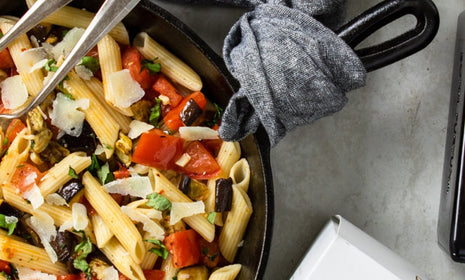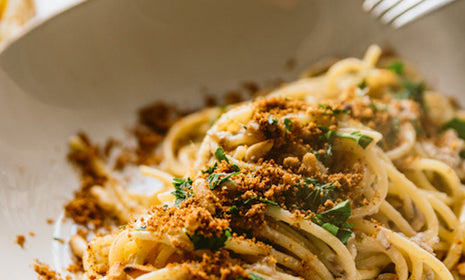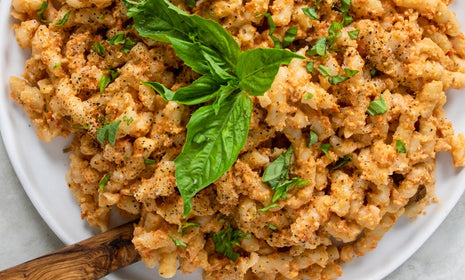Whether it’s the brand, the shape, or the ingredients that help you choose what pasta to keep in your pantry, we want to help answer some commonly raised questions about our pasta specifically, as well as the broader, oh-so-wonderful-world of pasta at large.

WHY DO SO MANY RECIPES CALL FOR RESERVING PASTA WATER?
When you eat pasta at a restaurant, have you ever noticed just how velvety the texture of the sauce is and how well it clings to each noodle? This is because they generally use one pot of continuously boiling water to cook their pasta throughout the night. When pasta cooks, it releases starch into the boiling, salty water. The resulting starchy water is both full of delicious briny flavors as well a wonderful thickener. By adding a dash of pasta water to whatever sauce you’re tossing your pasta in, it helps to thicken the sauce and bind it to each noodle, giving it that silky, luscious texture and additional flavor you relish at a great Italian restaurant.

SHOULD I RINSE MY PASTA IN COLD WATER AFTER COOKING?
Unequivocally no. When you rinse your pasta after cooking, you rinse off all the starchy goodness that is going to help cling to the sauce. You’re also washing away a lot of the delicious briny qualities that it has picked up from the salted cooking water. We do know that leaving your pasta drained, unrinsed, and unattended for too long can certainly leave you with a sticky mess. However, once you've added the pasta to a pan with a warm sauce, it will loosen its grip once more.

WHAT'S SO SPECIAL ABOUT ANCIENT GRAIN PASTA?
The main difference between ancient grains and modern grains is the purity of their genetic makeup. While modern grains have been genetically modified in order to grow bigger, resist pests, grow faster, etc., ancient grains have not been genetically modified, and therefore maintain their genetic integrity. They are the same today as they were four-thousand years ago. Why is this good? As a result of never being compromised for efficiency or bulk production, ancient grains have higher nutritional value: more protein, vitamins, and fiber than modernized grains. The body recognizes them better and thus are easier to digest. Bona Furtuna’s ancient grain pastas are minimally processed and carefully milled, producing highly flavorful pastas with great nutritional benefits.

WHAT PASTA SHAPE DO ITALIANS EAT THE MOST?
While this can vary depending on region, the most popular pasta shapes in Italy tend to be penne and spaghetti. While both are exceptional vessels for sauce, they each serve a different purpose when it comes to pasta eating. Where spaghetti is excellent for a simple cacio e pepe, penne is the perfect choice to serve with an arrabbiata sauce.
In Sicily, while spaghetti still holds a firm grip on households across the island, busiate is another favorite among locals. You’ll find it folded into a freshly made pesto alla trapanese all across Sicily.

WHAT ARE THE MOST POPULAR PASTA SHAPES?
In addition to the shapes mentioned above tagliatelle and fusilli are eaten across Italy with great enthusiasm. Contrary to American belief, most pasta consumed in Italy is in fact dried, not freshly made at home. Why? The same reason they’re eaten with such gusto in America: they’re a means to quick and delicious meals. As such, shapes like tortellini and ravioli, which are still greatly popular, are eaten with less frequency as they require more time to make.

CAN PASTA BE HEALTHY?
There are two main takeaways when thinking about pasta and its relation to health.
Firstly, if your pasta is made with ancient grains rather than genetically modified modern grains, it will, in most cases, have higher protein and nutrient values than the latter. The more processed a grain, the more refined its carbohydrate (i.e. sugar) content will be. Similarly, whole wheat pastas have higher fiber content than refined grain wheat pasta, making them more easily digestible and higher in nutritional value.
Secondly, the scale of your intake directly correlates to its overall health implications. Americans tend to be mystified that Italians can eat pasta with such regularity while remaining trim. If you go to a restaurant in Italy, however, you will notice that the portions that they serve pasta in are 2-3 times smaller than you might see in the United States. As a complex carbohydrate, pasta is something to be eaten in moderation, and enjoyed with gusto.
WHAT PASTA SHOULD I ORDER IN ITALY?
What pasta you should order in Italy depends entirely on where in Italy you are. If you’re in Rome, you cannot leave without indulging in at least a few carbonara. Spun into rendered guanciale with eggs, black pepper, and freshly grated pecorino Romano, spaghetti soaks up the creamy richness that you’ll be dreaming of the rest of your trip. When traveling through Campania, be sure to indulge in their infamous and savory puttanesca sauce. No food tour of Italy would be complete without a drive through Emilia-Romagna, where the tortellini en brodo is a must. Eaten around the world, transform your understanding of pesto with a taste of the Ligurian favorite, pesto alla genovese, made freshly in its hometown. And of course, try its sister, pesto alla trapanese, while touring through Sicily’s charming western town of Trapani. The list could, and does, go on and on, so be sure to research the regional favorites when traveling through Italy to ensure you get a true taste of the local heritage.

I HAVE A GLUTEN SENSITIVITY - WHY DOESN'T BONA FURTUNA PASTA AFFECT ME?
Gluten sensitivities are indications of your body’s inability to digest and process gluten proteins. More processed wheats tend to have higher gluten levels, particularly gliadins, a gluten protein that tends to cause more reaction to those who consume it. As ancient grains are less processed and have not been genetically modified to contain higher levels of gluten, some people may have an easier time digesting ancient grains. We hear from clients with sensitivities all the time who thought they couldn’t eat pasta anymore, but they don’t have any digestive issues with Bona Furtuna pasta.





Be the first to comment